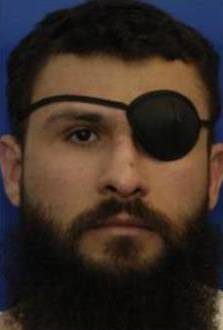
Abu Zubaydah is a Palestinian citizen and alleged terrorist born in Saudi Arabia currently held by the U.S. in the Guantanamo Bay detention camp in Cuba. He is held under the authority of Authorization for Use of Military Force Against Terrorists (AUMF).

Riduan Isamuddin, also known by the nom de guerreHambali, is the former military leader of the Indonesian terrorist organization Jemaah Islamiyah (JI). He is now in American custody at Guantanamo Bay detainment camp in Cuba. He is currently awaiting trial in a military commission.

Mohammed Mani Ahmad al-Qahtani is a Saudi citizen who was detained as an al-Qaeda operative for 20 years in the United States's Guantanamo Bay detention camps in Cuba. Qahtani allegedly tried to enter the United States to take part in the September 11 attacks as the 20th hijacker and was due to be onboard United Airlines Flight 93 along with the four other hijackers. He was refused entry due to suspicions that he was trying to illegally immigrate. He was later captured in Afghanistan in the Battle of Tora Bora in December 2001.
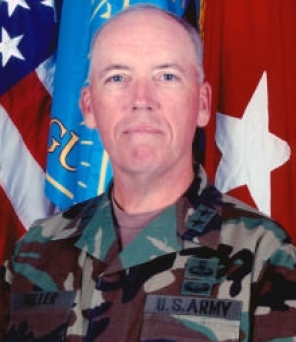
Geoffrey D. Miller is a retired United States Army major general who commanded the US detention facilities at Guantanamo Bay, Cuba, and Iraq. Detention facilities in Iraq under his command included Abu Ghraib prison, Camp Cropper, and Camp Bucca. He is noted for having trained soldiers in using torture, or "enhanced interrogation techniques" in US euphemism, and for carrying out the "First Special Interrogation Plan," signed by the Secretary of Defense, against a Guantanamo detainee.
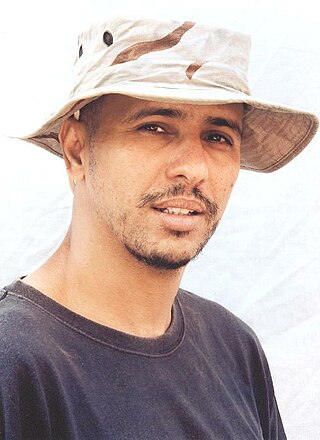
Mohamedou Ould Slahi is a Mauritanian engineer who was detained at Guantánamo Bay detention camp without charge from 2002 until his release on October 17, 2016.

Omar Amer Deghayes is a Libyan citizen who had legal residency status with surviving members of his family in the United Kingdom since childhood. He was arrested in Pakistan in 2002. He was held by the United States as an enemy combatant at Guantanamo Bay detention camp from 2002 until December 18, 2007. He was released without charges and returned to Britain, where he lives. His Guantanamo Internment Serial Number was 727. Deghayes says he was blinded permanently in one eye, after a guard at Guantanamo gouged his eyes with his fingers. Deghayes was never charged with any crime at Guantanamo.
Abu Bakker Qassim is a Uyghur from China's western frontier, Xinjiang Uyghur Autonomous Region who was held in the United States Guantanamo Bay detention camps, in Cuba. His Guantanamo Internment Serial Number was 283.
Extrajudicial prisoners of the United States, in the context of the early twenty-first century War on Terrorism, refers to foreign nationals the United States detains outside of the legal process required within United States legal jurisdiction. In this context, the U.S. government is maintaining torture centers, called black sites, operated by both known and secret intelligence agencies. Such black sites were later confirmed by reports from journalists, investigations, and from men who had been imprisoned and tortured there, and later released after being tortured until the CIA was comfortable they had done nothing wrong, and had nothing to hide.

Alberto José Mora is a former General Counsel of the Navy. He led an effort within the Defense Department to oppose the legal theories of John Yoo and to try to end the use of torture at Guantanamo Bay.
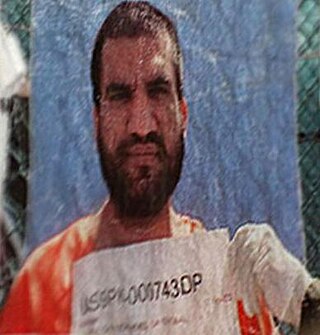
Muhammad Saad Iqbal is a Pakistani citizen who was held in extrajudicial detention in the United States Guantanamo Bay detention camps, in Cuba. Madni's Guantanamo Internment Serial Number was 743. The Department of Defense reports that he was born on October 17, 1977.

Tariq Mahmud Ahmad Muhammad al-Sawah is a citizen of Egypt who was held in the United States Guantanamo Bay detention camps, in Cuba, from May 2002 to January 2016.

Mohammed Ahmad Ghulam Rabbani is a citizen of Pakistan who was extrajudicially detained by the United States military at the Guantanamo Bay detention camp in Cuba from 2004 to 2023. He was never charged with a crime, was never tried, and was a subject of enhanced interrogation techniques.
"Enhanced interrogation techniques" or "enhanced interrogation" was a program of systematic torture of detainees by the Central Intelligence Agency (CIA), the Defense Intelligence Agency (DIA) and various components of the U.S. Armed Forces at remote sites around the world—including Bagram, Guantanamo Bay, Abu Ghraib, and Bucharest—authorized by officials of the George W. Bush administration. Methods used included beating, binding in contorted stress positions, hooding, subjection to deafening noise, sleep disruption, sleep deprivation to the point of hallucination, deprivation of food, drink, and medical care for wounds, as well as waterboarding, walling, sexual humiliation, rape, sexual assault, subjection to extreme heat or extreme cold, and confinement in small coffin-like boxes. A Guantanamo inmate's drawings of some of these tortures, to which he himself was subjected, were published in The New York Times. Some of these techniques fall under the category known as "white room torture". Several detainees endured medically unnecessary "rectal rehydration", "rectal fluid resuscitation", and "rectal feeding". In addition to brutalizing detainees, there were threats to their families such as threats to harm children, and threats to sexually abuse or to cut the throat of detainees' mothers.
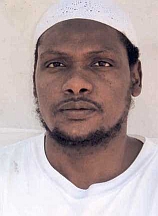
Mohammed Abdul Malik Bajabu is a citizen of Kenya currently held in administrative detention in the United States' Guantanamo Bay detention camps, in Cuba. He was born in Busia, Uganda, but has Kenyan citizenship. Abdul Malik was captured in February 2007, on suspicion of leading a terrorist bomb-plot in Mombasa. He was transferred to Guantanamo on 26 March 2007. Abdul Malik is a confirmed member of the East Africa al-Qaeda network as well as a confirmed member of the Council of Islamic Courts and the Islamic Part of Kenya. He "actively participated" in the facilitation of weapons and the planning of terrorist acts against the U.S., according to the Joint Task Force (JTF) at Guantanamo Bay. He was recommended for continued detention under the Department of Defense's control. The JTF gave Abdul Malik a high risk threat against the United States' interests and allies. He has no reports of disciplinary infractions as of May 22, 2007, granting him a low detention risk value. Abdul Malik does, however, have a high intelligence value.
Torturing Democracy is a 2008 documentary film produced by Washington Media Associates. The film details the use of torture by the Bush administration in the "War on Terror."
Rafiq Bin Bashir Bin Jalud al Hami is a citizen of Tunisia, who was formerly held for over seven years without charge or trial in the United States's Guantanamo Bay detention camps, in Cuba. His Guantanamo Internment Serial Number was 892. The Department of Defense reports that he was born on 14 March 1969, in Tunisia.
Guantanamo Bay homicide accusations were made regarding the deaths of three prisoners on June 10, 2006, at the United States Guantanamo Bay detention camp for enemy combatants at its naval base in Cuba. Two of the men had been cleared by the military for release. The United States Department of Defense (DOD) claimed their deaths at the time as suicides, although their families and the Saudi government argued against the findings, and numerous journalists have raised questions then and since. The DOD undertook an investigation by the Naval Criminal Investigative Service, published in redacted form in 2008.

Separate facilities exist to provide for Guantanamo detainees' medical care.
The Guantanamo Trap is a documentary film about four individuals whose lives were changed by their association with the Guantanamo Bay detention camps. The film was directed by Thomas Wallner and won the special jury prize at the 2011 Hot Docs Canadian International Documentary Festival.
Michael E. Dunlavey is a former major general in the United States Army. Following his retirement from the Army he was elected a State Judge in Erie Pennsylvania.












